Introduction
After teasing us for ages, Sony today announced what has already been all over town:
The Sony F5 & F55 cameras were just announced, alongside an entire range of workflow infrastructure that goes along with. It is one of the most massive announcements of new cameras to date, with Sony showing of a lot of “F” squarely aimed at challenging Red with their Epic, Canon with their C300/C500 and even Arri with their Alexa. Sony is truly flexing their muscles and showing off what they do best, providing entire production pipelines to go along with their cameras.
There’s a completely new codec, a 4K 30 inch monitor, new and faster SxS cards for high frame rate acquisition of this new codec (XAVC, see below), an all-new lineup of their prime lenses, even new batteries. Insane!
But let’s start with the most important bit …

Sony F5 and F55
Sony F5 & F55
The two cameras feature the same exact body, yet different 4K sensors, with the only visible difference being the silver ring around the mount of the F55. The F5 is positioned as a direct competitor to the C500, with 1080p/2K internal recording at up to 120fps. I have to add that both the F5 and the F55 seem to ship with “only” up to 60fps 1080p at the beginning, but with a “planned free upgrade” they will be able to shoot 120fps in XAVC 2k/HD on board (F5/F55), and 120fps raw with the optional AXS-R5 outboard recorder. The F55 will be able to record up to 180fps internally in XAVC 2K/HD, and 240fps 2K raw with the AXS-R5. Confusing!
Here are Sony’s details on the F5 frame rates:
High speed shooting at up to 120 fps in 2K
From stunts and explosions to the fall of a single raindrop, high-speed shooting is a powerful storytelling tool.
- 60 fps out of the box (XAVC HD).
- 120 fps with a planned upgrade (XAVC 2K/HD). Unique to this process, there is no line skipping or sensor windowing. So there’s no crop factor, no loss in angle of view.
- 120 fps 2K RAW, with the optional AXS-R5 outboard recorder and a planned upgrade, achieves high frame rates while retaining exceptional, 16-bit image quality. This not only exceeds 12-bit RAW with 16 times as many Red, Green and Blue gradations. By design, it exceeds the capabilities of human vision!
F55 frame rates:
High speed shooting at up to 240 fps in 2K
From stunts and explosions to the fall of a single raindrop, high-speed shooting is a powerful storytelling tool.
- 60 fps out of the box (XAVC HD at launch; XAVC 4K, QFHD and 2K with a planned upgrade)
- 180 fps with a planned upgrade (XAVC 2K/HD). Unique to this process, there is no line skipping or sensor windowing. So there’s no crop factor, no loss in angle of view.
- 240 fps 2K RAW, with the optional AXS-R5 outboard recorder and a planned upgrade, achieves the highest frame rates most productions will need, while retaining exceptional, 16-bit image quality. This not only exceeds 12-bit RAW with 16 times as many Red, Green and Blue gradations. By design, it exceeds the capabilities of human vision!
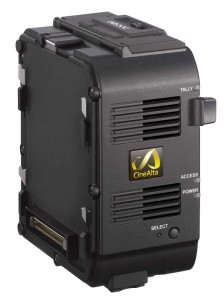
The Sony AXS-R5 raw recorder (rolls off the tongue, doesn’t it?) for 4K raw with the F5 & F55
Only the F55 will be able to record 4K internally, also in the new XAVC codec. The F5 needs the external recorder for 4K acquisition – just like a C500. With the biggest difference being that Canon doesn’t do their own recorder, meaning that you have to get a third-party solution like the upcoming KiPro Quad or the Gemini 444 recorder with its promised 4k upgrade. The downside? Cables running from the camera to the recorder, and that’s the main problem I have with external recorders. Sony’s new AXS-R5 recorder (how do they come up with these names, seriously??) just sticks on the back of the F5/F55 without any fuss – very neat solution indeed!
The F5 ONLY outputs 4K in raw … there seems to be no possibility to the 4K XAVC codec out of the F5. For the output, both cameras feature 4 SDI-ports.
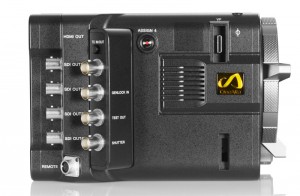
Side view from the right … loads of SDI ports for 4K output.
Sony says both the F5 and F55 have a 14 stop exposure latitude. If this holds true it will on par or even beat Canon, very impressive. And in 16 bit colour depth.
The native mount is the FZ mount like on the F3, but with an included PL adapter.
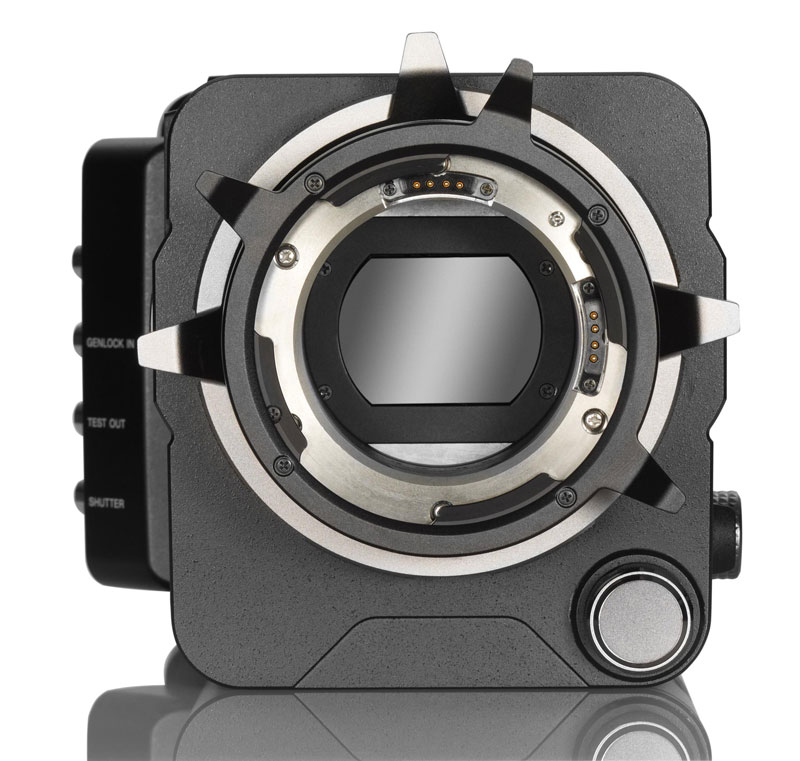
FZ mount with PL mount adapter (included)
Global Shutter in the F55
Sony has impressively pulled off something that we have been waiting for years since the first CMOS sensors were introduced: they managed to build a global electronic shutter for their F55, meaning that this camera will know no rolling shutter artifacts like we have them on all other CMOS based cameras to a certain degree. That means it is possible to use this cameras much more easily for fast movement and action shoots. No more skewed buildings, trucks and so on! This is a massive development and hopefully it will find its way into all new cameras sooner or later. It was probably the only still remaining downside of CMOS sensors compared to traditional CCD sensors.
Codec
That brings us to one of the most interesting innovations: Sony has a new codec build into the F5 and F55 (after a planned upgrade, they say – which seems to mean that it’s not finished when the cameras initially ship), XAVC HD/2K (F5/F55) and XAVC 4K (QFHD) (F55 only), which are a great combination of efficiency and quality. Both are 4:2:2 10bit, with the HD variety at 100Mbps and the 4K variety at 300Mbps.
Efficient codecs are extremely important and getting more important all the time with higher resolutions – simply because raw footage is really hard to stomach especially with high resolutions. It’s something that everybody asks for but also something that hardly anyone can actually handle in post production. The 2.5K raw image out of a Blackmagic Cinema Camera, for instance, takes up 256GB in little over 30 minutes. Imagine how much data you will create with in 4k raw. It’s something not even Hollywood TV series shoot at, they mainly use the ProRes option that the Arri Alexa offers, rather than the raw recording that’s also possible. I recently shot footage for the
NBC series Grimm on the C300 in Vienna (to be aired in the coming episodes) – talking about “overkill” with raw footage!!
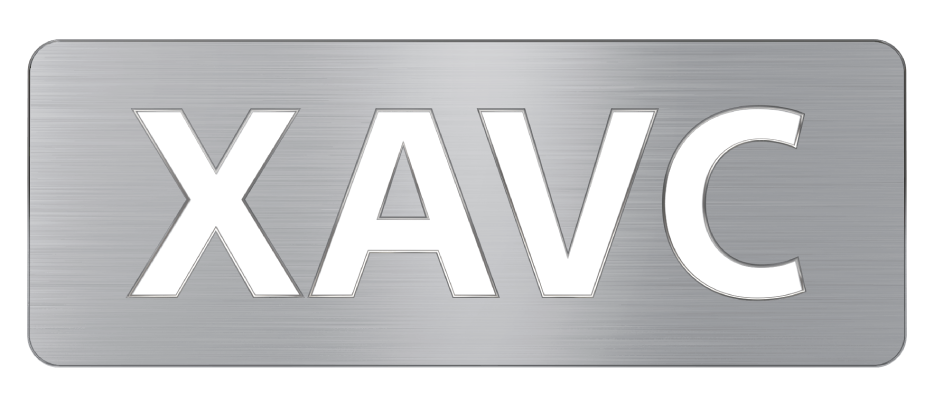
Sony XAVC codec … a very promising development.
So the XAVC codec is very promising and that’s Sony really showing its strengths over Canon – Canon only recently got into the cinema game, and I am a big fan and owner of a C300, as I have stated many times before, but they don’t have the capacity for codec development as companies like Sony or Panasonic do. Actually, the 50Mbps 4:2:2 codec used in the C300 is great, but my guess is that it’s under license from Sony’s XDCAM HD codec. Sony on the other hand seemingly put quite a bit development effort into the XAVC codec and it FINALLY replaces the 4:2:0 XDCAM EX codec which was great when it was first released with the EX1/3 – but it was totally underpowered for the Sony F3, which is a camera that can deliver SO much more, but only with external recording. I expect Sony to bury that codec now with XAVC coming.
It’s a bit surprising that the codec is scheduled to be released as a free upgrade after the cameras’ scheduled release date in January/February 2012 … so I think development is still happening as we speak. I expect them to release all these free upgrades regarding this codec (which also seems to include the internal 4K recording capability for the F55) right at NAB 2013, because it neatly takes place in April. That should give them enough time and that’s probably what they are aiming for (thanks for that added thought,
Johnnie!).
Ergonomics
Ergonomically both cameras are the same, as mentioned above, but the form factor truly looks like they listened to cinematographers. There’s an optional shoulder pad and it just sits on your shoulder like cameras used to in the old days. The form factor is good and strikingly similar to the Alexa, BUT it it will be a problem for shoots in tiny spaces. (That’s why pros like Rodney Charters use the C300 as a B camera to the Alexa on shows like “Shameless” or “Dallas”.) The downside of this somewhat traditional Sony shoe-box design is that it’s hard to get into these tiny spaces. But hey, I am not complaining … this works SO much better than the F3 design with the (really bad) viewfinder on the back of the camera. Also, the
As far as I can tell, Sony ships the F5 with a 0.7″ OLED viewfinder with 720p resolution, which is quite impressive indeed. There is an optional 7″ viewfinder with 1080p. The F55 is shipped with no viewfinder at all. Their optional shoulder rig comes with industry-standard rosettes on either side, which is nice and makes it very attractive for third party solutions as well.
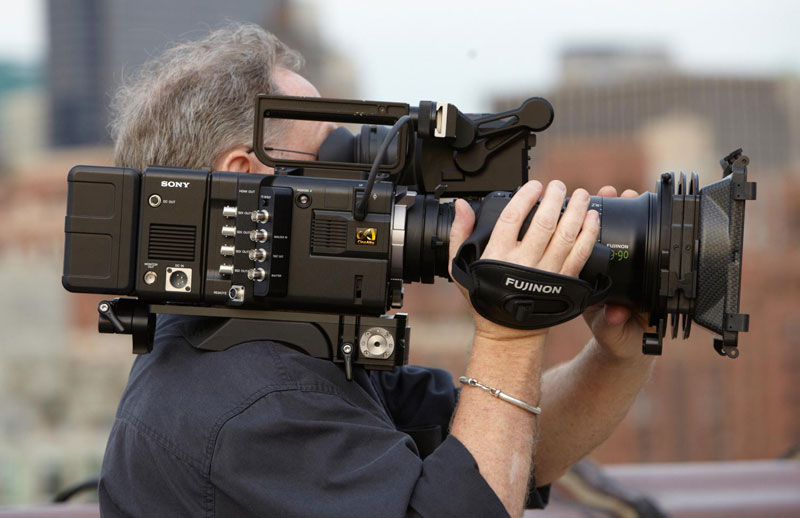
The F55 with the shoulder rig … image courtesy of FDtimes
The XLR audio part is detachable, similar to Canon’s concept on the C300/C500, which I quite like, because it allows you to make the camera even smaller. Where these XLR ports will exactly be, I can’t tell, because I can’t see them on any of the press images yet.
Acquisition – Sony SxS PRO+ cards
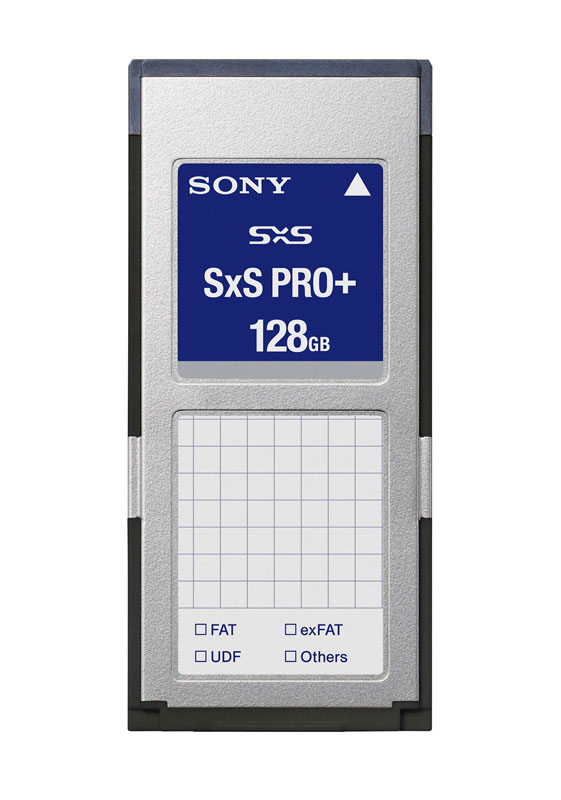
The Sony SxS Pro+ card. And you thought we were done with Sony’s proprietary standards …
Sony is also introducing a new breed of SxS cards to allow on-board recording of 120fps XAVC 2K/HD footage on the F5 and 180fps on the F55. I expect them not to be cheap, just as normal Sony SxS Pro cards were never really cheap (actually they went down in price and Sony even introduced the cheaper SxS-1 cards to compete with SDHC adapters for the EX1/EX3/F3 cameras, but they still are much more expensive than normal fast CompactFlash or SDHC cards). I hope the pricing on these to be more reasonable than on the initial SxS Pro cards, because that nearly killed EX3 owners like myself when they first released them.
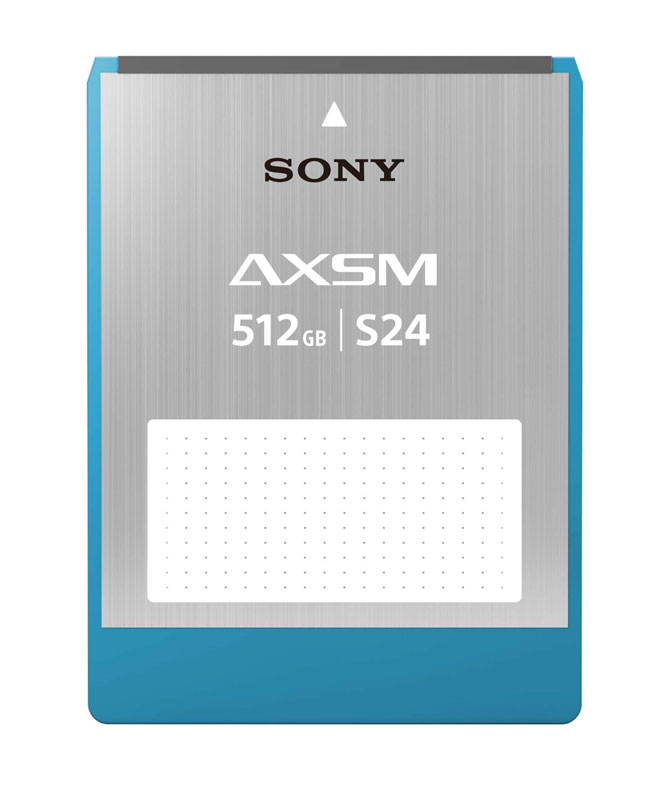
… far from it!! That’s their new AXSM memory card … basically a rehoused SSD sold at a much higher price (we know that from Red already).
Lenses
Sony also releases a whole new range of CineAlta PL-lenses to go with the cameras – they are specifically touting the “dramatic improvement in build quality”, which was really one of the biggest problems of their first prime lenses, compared to much higher-quality products from Zeiss or the new Canon Cine Primes. I have yet to see the image out of these to make a judgement (that is of course true for all of today’s announcements), but it’s nice to see they are pushing in this direction as well.
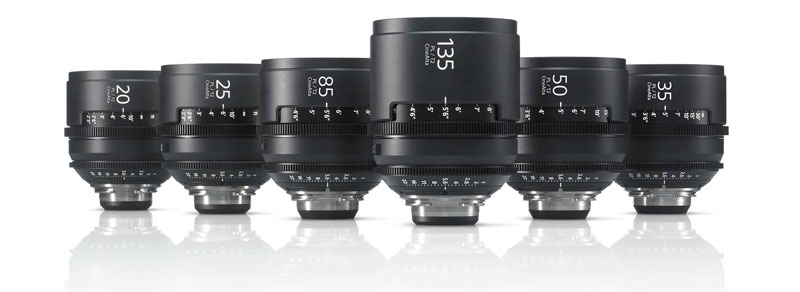
Sony’s all-new range of CineAlta PL-mount lenses
F65 upgrade
Sony’s existing 4K top-of-the-line model gets a firmware upgrade to shoot 8K. I have really trouble seeing a market for this kind of camera now that the F5 and F55 seem to do it all … especially considering that only a tiny fraction of all cinema screens feature even a 4K projector (most of them are 2K still). So I don’t know where that leaves 8K. Future-proof? For sure. A very distant future. Most eyes are not able to tell the difference between a 1080p image and a 4K image on a large TV with a normal viewing distance. So I honestly doubt there’s a market for 4K TVs … let alone 8K projectors. But I could be wrong. At least it gives you a lot to play with for reframing, which might be both good and bad (bad for a cinematographer that is not involved in the post production process as his images might be changed drastically).
Other new products
There are many other new products, a 30 inch 4K monitor (nice, allows you to actually see what you shoot with these shiny new 4K cameras), new batteries (new technology by Sony that allows for more recharging cycles), and a new card reader for the SxS Pro+ cards.
Pricing
No pricing for the cameras is yet confirmed, but the rumored price for the F5 is $18K, and “less than $50K” for the F55. The external raw recorder AXS-R5 is rumored to cost around $10K, which would be quite a steep price indeed … I just heard from my buddy Den Lennie who’s attending the London Sony event that it WILL indeed be possible to use third party 4K recorders to extract a 4K signal from HD-SDI, so the F5 will indeed be a direct competitor to the C500, being able to handle less expensive external recorders as well! Thanks Den!
I will be talking about the FS700 4K upgrade in a separate post.
UPDATE – F55 hands-on video by Sony UK:
Sony UK has released a long hands-on video on the PMW-F55 moderated by Richard Lewis, their Cinematography Product Specialist.
Richard Lewis, Cinematography Product Specialist, provides a detailed, hands-on tour of the new CineAlta 4K cameras PMW-F55 and PMW F5.
He shows all the key features like its modular structure, the several recording formats, menu controls and battery as well as the raw recorder accessories. The 18 minute video also includes details on recording on SxS Pro+ and AXSM memory cards, including RAW and XAVC codecs.

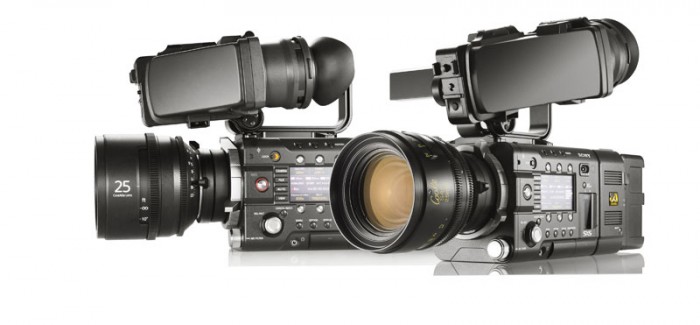











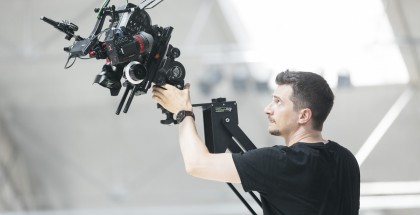

















Comments